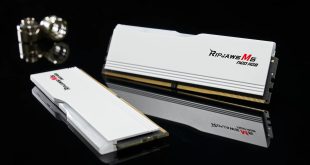A researcher at the University of Victoria, British Columbia, has developed a new technology for use with a magneto-resistive type of memory which promises to solve part of the universal memory dilemma equation.
Dr. Natia Frank, an Associate Professor and Researcher at the UVic Department of Chemistry, has patented what she is calling LI-RAM, or Light-Induced Random-Access Memory, and before you get all Tron-ny on us, this is actually a new material which is used in a similar way to current MRAM technology, only it is photo-sensitive and reads/writes are made through lightwaves instead of electrical current, effectively changing the magnetic field of the target when it is hit with a green light. A target which can be as small as a molecule.

So how big a deal can this be, if it ever takes off? It means that storage “cells” could be tiny, measured in Angstroms rather than Nanometers (or 10:1). Just for comparison, your modern-day Samsung 3D V-NAND Flash cell is 21nm in length, or 210 times bigger than an Angstrom. It also means that the power requirements for operating a device's RAM/storage would drop significantly as it replaces both with a much more energy-efficient solution. Right now, the researcher is promising a 10% reduction in power consumption of these devices when compared to standard MRAM technology.
The message is: you can pack a lot more data in a very small area, while using a lot less power (and generating less heat output) and simultaneously replacing your hard-drive and RAM. Higher density than RAM or NAND with less heat and higher performance.
The research, which has been announced as part of a wider initiative to reduce power consumption in computing and create a more environmentally-friendly type of RAM (Information Technology now accounting for 10% of the worlds power consumption), can see multiple applications beyond IT. “Potentially, this material could have other uses in medical imaging, solar cells and a range of nanotechnologies,” says Frank. “This is just the beginning.”
There is a slight caveat, however: the UVic blog says the technology can take as long as 10 years to reach consumers.
Here's the researcher herself explaining what she's been working on.
KitGuru Says: The more dependent a device is on RAM and storage, the bigger the power savings. In computing, massive datacentres can (theoretically) save a bunch as the non-electric read/write method emits less heat and, we expect, will pack more density. Now, like all technologies that promise a lot, we'll reserve judgement until it actually reaches the market.
 KitGuru KitGuru.net – Tech News | Hardware News | Hardware Reviews | IOS | Mobile | Gaming | Graphics Cards
KitGuru KitGuru.net – Tech News | Hardware News | Hardware Reviews | IOS | Mobile | Gaming | Graphics Cards



Google is paying 97$ per hour! Work for few hours and have longer with friends & family! !mj209d:
On tuesday I got a great new Land Rover Range Rover from having earned $8752 this last four weeks.. Its the most-financialy rewarding I’ve had.. It sounds unbelievable but you wont forgive yourself if you don’t check it
!mj209d:
➽➽
➽➽;➽➽ http://GoogleFinancialJobsCash209HomeTalkGetPay$97Hour… ★★✫★★✫★★✫★★✫★★✫★★✫★★✫★★✫★★✫★★✫★★✫★★✫★★✫★★✫★★✫★★✫★★✫★★:::::!mj209d..,.,………